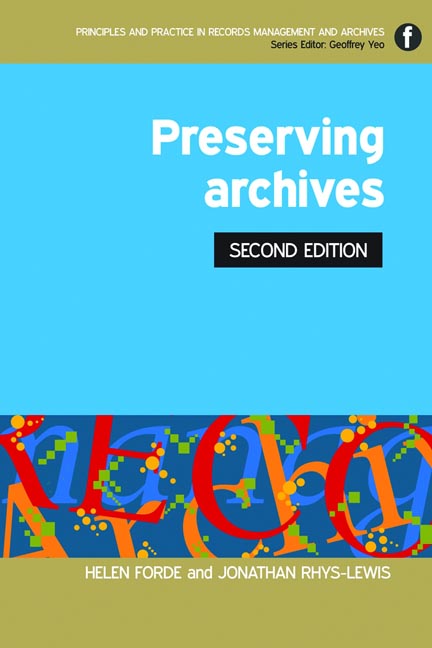Book contents
- Frontmatter
- Contents
- Introduction to the series Geoffrey Yeo
- Preface to the Second Edition
- Acknowledgements
- 1 Introducing archive preservation
- 2 Understanding archival materials and their characteristics
- 3 Managing digital preservation
- 4 Archive buildings and their characteristics
- 5 Safeguarding the building and its contents
- 6 Managing archival storage
- 7 Managing risks and avoiding disaster
- 8 Creating and using surrogates
- 9 Moving the records
- 10 Exhibiting archives
- 11 Handling the records
- 12 Managing a pest control programme
- 13 Training and the use of volunteers
- 14 Putting preservation into practice
- Appendices
- Bibliography
- British and international standards relating to archive preservation
- Index
2 - Understanding archival materials and their characteristics
Published online by Cambridge University Press: 09 June 2018
- Frontmatter
- Contents
- Introduction to the series Geoffrey Yeo
- Preface to the Second Edition
- Acknowledgements
- 1 Introducing archive preservation
- 2 Understanding archival materials and their characteristics
- 3 Managing digital preservation
- 4 Archive buildings and their characteristics
- 5 Safeguarding the building and its contents
- 6 Managing archival storage
- 7 Managing risks and avoiding disaster
- 8 Creating and using surrogates
- 9 Moving the records
- 10 Exhibiting archives
- 11 Handling the records
- 12 Managing a pest control programme
- 13 Training and the use of volunteers
- 14 Putting preservation into practice
- Appendices
- Bibliography
- British and international standards relating to archive preservation
- Index
Summary
Introduction
Archival materials are complex in their manufacture and use, and some understanding of their history and different characteristics is important for successful preservation. The chemistry involved is largely the preserve of conservators undertaking pure and applied research, but some basic knowledge, particularly of modern materials, is necessary. Paper and parchment constitute the vast majority of carriers – excluding magnetic materials and electronic media – in most archives in the UK and many other countries. Other materials, such as palm leaves or bark, are found elsewhere in the world, but are rare in Europe and are not covered here. Understanding the problems of different materials is one thing; finding the solutions is quite another and these will depend upon the circumstances in each archive. There are, however, two exceptions; these relate to nitrate-based and cellulose acetate-based film, both of which may deteriorate quickly, or in the worst case, self-combust or explode, if action is not taken upon discovery of degradation.
This chapter looks at the structure and manufacture of the materials most commonly found in UK and many other archives throughout the world, including:
• paper
• parchment
• inks
• photographic materials
• audiovisual materials
• optical materials
• tapes
• discs
• digital storage media.
Paper
Paper is the material most widely used for archives and therefore merits particular attention. The materials from which it is made have varied over time, resulting in more or less stability; this ref lects the common perception of paper as a disposable product, but in practice it is a remarkably resilient writing medium.
The development of paper
The Chinese invention of paper in AD105, as an alternative writing medium to silk or cloth, has traditionally been associated with ’i Lun, of Hunan province, although some recent discoveries suggest that it was being used at least a century earlier. Wadding has also been discovered in a tomb in Shanxi province but the structure provides no evidence of fibre beating, an essential operation which forms the hydrogen bondings which distinguish sheet paper from wadding.
In the Western world paper began to rival papyrus in the late eighth century AD, although Chinese paper makers are known to have been in Turkey as early as 648 and had passed on the art to the Arabs by the middle of the eighth century.
- Type
- Chapter
- Information
- Preserving Archives , pp. 5 - 24Publisher: FacetPrint publication year: 2013

